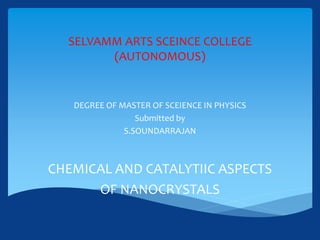Catalysis newton sow
- 1. SELVAMM ARTS SCEINCE COLLEGE (AUTONOMOUS) DEGREE OF MASTER OF SCEIENCE IN PHYSICS Submitted by S.SOUNDARRAJAN CHEMICAL AND CATALYTIIC ASPECTS OF NANOCRYSTALS
- 2. ïŠ Introduction ïŠ Chemical properties ïŠ Surface chemistry process ïŠ Nanomaterial in catalysis Plane of talk
- 3. ïŠ ïŠ Physicist Richard Feynman ,The father of nanotechnology Introduction
- 4. Plenty of Room at the Bottom âĶ But there is plenty of room to make them smaller The idea behind nanotechnology originated with Nobel Laureate Richard Feynman nearly 50 years ago. There is nothing that I can see in the physical law that says the elements cannot be made enormously smaller than they are now. âĶ. Richard Feyman December 29, 1959 The annual meeting of the American Physical Society at Caltech
- 5. Nanotechnology ïŠ Nano science and nanotechnology are the study and application of extermely small things and can be used across all the other science fields , such as chemistry , physics ,biology , materials science , and engineering. ïŠ just how small nanotechnology is are nanometer is a 10â9 nm
- 6. 1 m 10 cm 1 cm 100 ïm 10 ïm 1 ïm 100 nm 10 nm
- 7. ïŠSurface features ïŠNanocrystal superlattices ïŠDiblock copolymers and others including ïŠcatalysis Chemical properties
- 8. ïŠCorrosion ïŠAdsorption ïŠOxidation ïŠReduction ïŠcatalysis Surface chemistry is very importance in numerous process such as
- 9. corrosion
- 12. catalysis
- 13. Nanomaterials in catalysis Metallic nanoparticles exhibit different catalytic activities as follows Electronic effects Support effects Shape effects Recent progress Metal oxides and sulfides
- 15. Electron density charges may be vary due to particle size Ex: Nickel Electronic effects
- 16. Small metal particle bound to a metal oxide surface can be affected electronically by the nature of metal oxide mgoâ ðð + ð Support effects
- 17. Shape effects
- 18. Recent progress
- 19. Methanol synthesis over a zno catalysist is well known ðð2+3ðŧ2 â ðķðŧ3OH+ðŧ2 ð metal oxides and sulfides
- 20. THANK YOU



















